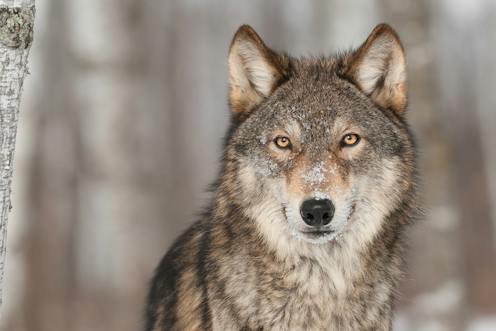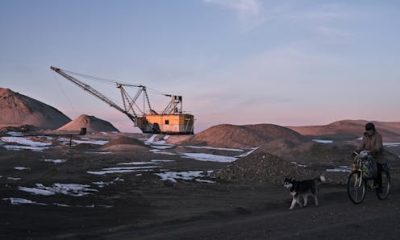
Gray wolves have been on the endangered species list since 1974. hkuchera/iStock via Getty Images Plus
Gray wolves were reintroduced to Colorado in December 2023, the latest attempt in a decadeslong effort to build up wolf populations in the Rocky Mountain states. SciLine interviewed Joanna Lambert, professor of wildlife ecology and director of the American Canid Project at the University of Colorado Boulder, who discussed how and why gray wolf populations declined in the U.S. and the value of reintroducing them to ecosystems in the West.
Dr. Joanna Lambert discusses the gray wolf restoration campaign.
Below are some highlights from the discussion. Answers have been edited for brevity and clarity.
How can protecting gray wolf populations affect ecosystems?
Joanna Lambert: Apex predators, and predators in general, are disappearing from landscapes around the planet.
Without apex predators, their prey species can become overly abundant. But when apex predators are reintroduced, prey populations decrease and vegetation can rebound. So in certain habitats of Yellowstone National Park, plant species such as willow and aspen are now in greater abundance since wolves were reintroduced in the 1990s. This denser vegetation can provide nesting areas for certain bird species and ideal conditions for beavers to set up dams, which can shift the hydrology of rivers and streams.
In Yellowstone, these effects are localized. Keep in mind that the reintroduction of wolves into Colorado covers a huge area, around 22 million acres of public lands, and there aren’t going to be that many wolves introduced – probably 30 or 50 over the next three to five years. So in Colorado, too, effects on vegetation and total numbers of prey species like elk are likely to be localized, diffuse and only within certain microhabitats.
What is special about the reintroduction in Colorado?
Joanna Lambert: This is the first time an endangered species will be managed and reintroduced into a former range by an entity other than the U.S. Fish and Wildlife. Instead, this reintroduction will be handled by Colorado Parks and Wildlife. This in itself is truly historical and groundbreaking. Instead of being a federal level initiative, this was the result of a citizen-led ballot initiative – Proposition 114 – that was voted into law as of November 2020.
Read more:
Will Colorado bring back wolves? It’s up to voters
How were the wolves reintroduced to the area?
Joanna Lambert: Those wolves were darted and immobilized in Oregon by expert marksmen and biologists working from a helicopter. They were netted and then brought onto small planes and eventually transported to vehicles, which took them to the regions where they were released. Those animals are radio collared and will be monitored carefully over months and years. The Colorado Parks and Wildlife aim to release 10-15 wolves this winter.
How have gray wolf populations changed in the U.S. over time?
Joanna Lambert: Before the arrival of Western settlers over 400-plus years ago, scientists estimate the total number of gray wolves roaming the North American continent was maybe between 500,000 to 2 million.
By the time we get to the mid-1960s, only roughly 200 to 400 breeding pairs of gray wolves lived in the lower 48. This is largely a consequence of a concerted effort on the part of multiple legislative entities – local, regional, state and federal – to remove predators. Reducing the number of wolves through hunting, shooting, trapping and poisoning was extremely effective.
The numbers of gray wolves plummeted throughout the 20th century so that we only have a handful around by the time the Endangered Species Act was signed into law in 1973. Gray wolves were one of the very first mammal species to be put onto the endangered species list in 1974.
The number of gray wolves has increased throughout the United States but are concentrated in two populations. One is in the upper Midwest region, in Minnesota, Wisconsin and Michigan, where there are probably about 4,500 wolves.
In the Northern Rockies, and that includes the states of Idaho, Wyoming, Montana, eastern Oregon and eastern Washington, we probably have somewhere around 2,500 to 3,000 wolves. These wolves are largely a consequence of the reintroductions that took place in Idaho and in Yellowstone in the mid-1990s.
The dramatic release happened 80 years after gray wolves were eradicated from the state.
How can humans coexist with gray wolves?
Joanna Lambert: Up until around 100 years ago, humans had been coexisting and living alongside gray wolves for thousands of years, so we do have the knowledge on how to coexist with predators. We are now at a point where that information and that knowledge has to be relearned.
That can include any number of scare devices or hazing tactics that can be used with both livestock and predators. It can include range riders working to make sure that they know where the wolves are. Ranchers can make changes in how animals are herded up and moved. Making these changes will take time, but Colorado Parks and Wildlife will be involved in those conversations and in the training of ranchers on how to keep their livestock safe. A number of nonprofits will also be involved in educating the public.
How does this reintroduction fit into the global extinction crisis?
Joanna Lambert: We are living in what many experts describe as the sixth extinction and are on the verge of losing upwards of a million species in the next couple of decades. Conservation biologists and practitioners around the world are working to offset this massive extinction. Reintroduction of important keystone species like gray wolves is one tool that can help.
Watch the full interview to hear more.
SciLine is a free service based at the nonprofit American Association for the Advancement of Science that helps journalists include scientific evidence and experts in their news stories.
Joanna Lambert does not work for, consult, own shares in or receive funding from any company or organisation that would benefit from this article, and has disclosed no relevant affiliations beyond their academic appointment.
Advertisement

Advertisement
Contact Us
If you would like to place dofollow backlinks in our website or paid content reach out to info@qhubonews.com











